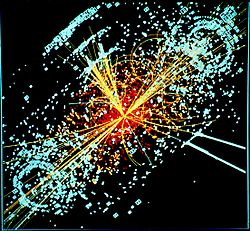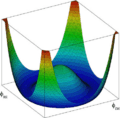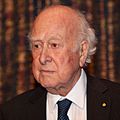Higgs boson facts for kids

|
|
| Composition | Elementary particle |
|---|---|
| Statistics | Bosonic |
| Status | A Higgs boson of mass ≈125 GeV has been tentatively confirmed by CERN on 14 March 2013, although it is unclear as yet which model the particle best supports or whether multiple Higgs bosons exist. |
| Theorised | R. Brout, F. Englert, P. Higgs, G. S. Guralnik, C. R. Hagen, and T. W. B. Kibble (1964) |
| Discovered | Large Hadron Collider (2011-2013) |
| Mass | 125.09±0.21 (stat.)±0.11 (syst.) GeV/c2 (CMS+ATLAS) |
| Mean lifetime | 1.56×10−22 s (predicted) |
| Decays into | bottom-antibottom pair (predicted) two W bosons (observed) |
| Electric charge | 0 e |
| Colour charge | 0 |
| Spin | 0 (tentatively confirmed at 125 GeV) |
| Parity | +1 (tentatively confirmed at 125 GeV) |

The Higgs boson (or Higgs particle) is a particle in the Standard Model of physics. In the 1960s Peter Higgs was the first person to express the idea. Paul Dirac named this class of particles "bosons" in honour of a famous Indian scientist Satyendra Nath Bose. On 14 March 2013, scientists at CERN tentatively confirm that they have found the particle.
It is one of the 17 particles in the Standard Model. The Higgs particle is a boson. Bosons are thought to be particles which are responsible for all physical forces. Other known bosons are the photon, the W and Z bosons, and the gluon. Scientists do not yet know how to combine gravity with the Standard Model.
The Higgs field is a fundamental field of crucial importance to particle physics theory. Unlike other known fields such as the electromagnetic field, the Higgs field takes a non-zero constant value almost everywhere. The question of the Higgs field's existence has been the last unverified part of the Standard Model of particle physics and, according to some, "the central problem in particle physics".
It is difficult to detect the Higgs Boson. Due to their massive size (compared with other particles) it needs vast amounts of energy to create them. The Large Hadron Collider at CERN was built mainly for this. It accelerates two sets of partials to almost light speed (travelling in opposite directions), before setting them on a path to collide with each other.
Each collision produces a flurry of new particles which are detected by detectors around the point where they collide. There is still only a very small chance, one in 10 billion, of a Higgs Boson appearing and being detected, so the LHC needs to smash together trillions of partials, and supercomputers need to sift through a massive amount of data to find the few collisions where evidence of the Higgs boson is.
Higgs bosons obey the conservation of energy law, which states that no energy is created or destroyed, but instead it is transferred. First, the energy starts out in the gauge boson that interacts with the Higgs field. This energy is in the form of kinetic energy as movement. After the gauge boson interacts with the Higgs field, it is slowed down. This slowing reduces the amount of kinetic energy in the gauge boson. However, this energy is not destroyed. Instead, the energy is converted into mass-energy, which is normal mass that comes from energy. The mass created is what we call a Higgs boson. The amount of mass created comes from Einstein's famous equation E=mc2, which states that mass is equal to a large amount of energy (for example, 1 kg of mass is equivalent to almost 90 quadrillion joules of energy—the same amount of energy used by the entire world in roughly an hour and a quarter in 2008). Since the amount of mass-energy created by the Higgs field is equal to the amount of kinetic-energy that the gauge boson lost by being slowed, energy is conserved.
Higgs bosons are used in a variety of science fiction stories. The physicist Leon Lederman called it the "God particle" in 1993. He used this name to get attention and support for experiments to detect the particle. However, most scientists do not like this name, because the particle has nothing to do with any kind of god and the nickname might confuse people.
Possible claims
On 12 December 2011, the two teams at the Large Hadron Collider looking for the Higgs Boson, ATLAS and CMS, announced that they had finally seen results which could suggest the Higgs Boson particle existed; however, they did not know for certain if this was true.
On 4 July 2012, the teams at the Large Hadron Collider declared that they had discovered a particle which they think is the Higgs boson.
On 14 March 2013 the teams had done much more testing, and announced that they now think the new particle was a Higgs boson.
Images for kids
-
The "Mexican hat-shaped" potential of the Higgs field is responsible for some particles gaining mass.
-
Nobel Prize Laureate Peter Higgs in Stockholm, December 2013
-
"Symmetry breaking illustrated": – At high energy levels (left) the ball settles in the centre, and the result is symmetrical. At lower energy levels (right), the overall "rules" remain symmetrical, but the "Mexican hat" potential comes into effect: "local" symmetry inevitably becomes broken since eventually the ball must at random roll one way or another.
-
Photograph of light passing through a dispersive prism: the rainbow effect arises because photons are not all affected to the same degree by the dispersive material of the prism.
See also
 In Spanish: Bosón de Higgs para niños
In Spanish: Bosón de Higgs para niños




